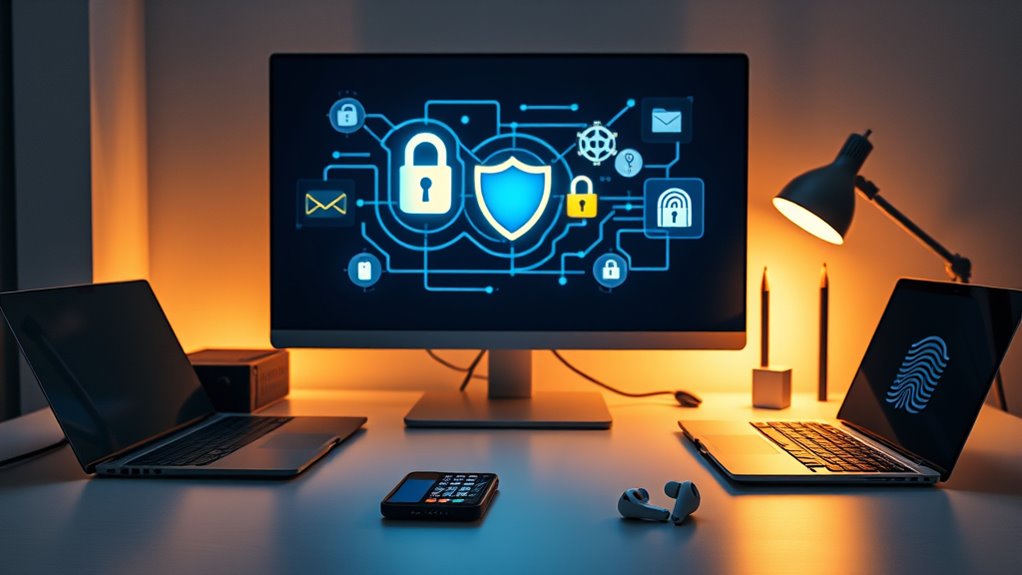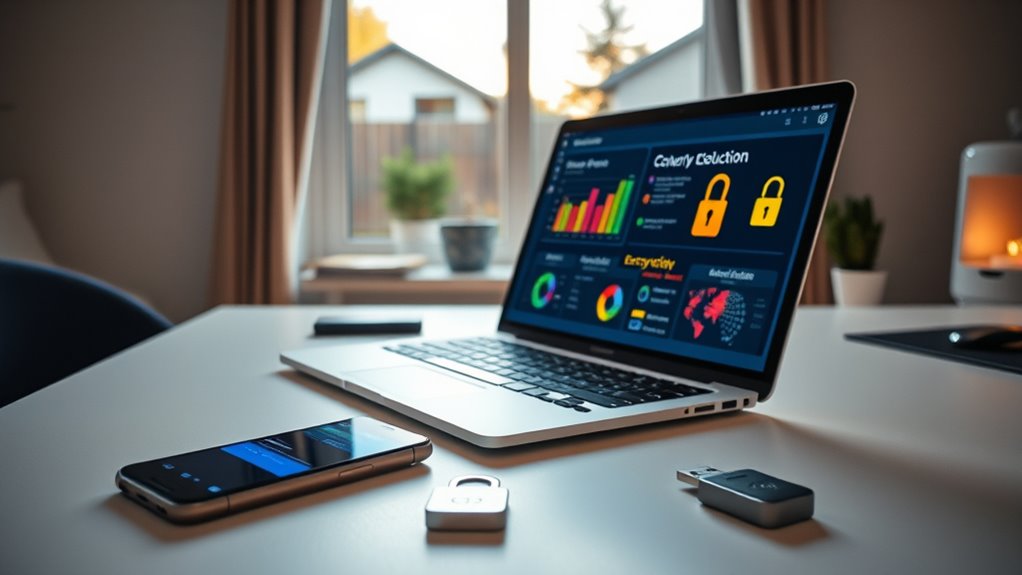To secure your home office for remote work, you should use strong, unique passwords for all accounts and manage them with a reliable password manager. Enable a trusted VPN like OpenVPN or WireGuard to create a secure connection before accessing sensitive data. Keep your software updated regularly to patch vulnerabilities and stay aware of cyber threats targeting remote workers. Implementing these basic cybersecurity measures makes your remote setup much safer; learn more about boosting your home office security next.
Key Takeaways
- Use strong, unique passwords combined with a password manager to secure all accounts and reduce hacking risks.
- Always activate a trusted VPN like OpenVPN or WireGuard before accessing sensitive work resources remotely.
- Keep software, operating systems, and security tools up to date to protect against the latest cyber threats.
- Implement multi-factor authentication (MFA) for remote access to add an extra security layer.
- Educate yourself on cyber threats and follow best practices to maintain a secure and resilient home office environment.

Have you ever wondered how safe your remote work setup is from cyber threats? With more people working from home, understanding how to protect your digital environment becomes essential. One of the most effective ways to safeguard your connection is by using a Virtual Private Network (VPN). But not all VPNs are created equal. Different VPN protocols offer varying levels of security and speed, so choosing the right one matters. Protocols like OpenVPN and WireGuard are known for their strong encryption and reliability, giving you a secure tunnel to access company resources. When you connect through a trusted VPN protocol, you help prevent hackers from intercepting sensitive data, especially when using unsecured Wi-Fi networks. This added layer of security is critical because cybercriminals often target remote workers who rely solely on their internet connection without additional safeguards. Additionally, selecting a VPN with strong encryption protocols enhances overall data protection during remote sessions.
Alongside using a VPN, effective password management is another cornerstone of remote cybersecurity. Many people underestimate the importance of strong, unique passwords for each account. Creating complex passwords that combine uppercase and lowercase letters, numbers, and symbols can greatly reduce the risk of unauthorized access. Using a password manager makes this process easier and more secure. Instead of trying to remember dozens of passwords, you store them all safely within a password management tool that encrypts your data. This way, you only need to remember one strong master password, and the manager takes care of the rest. It also helps you avoid common pitfalls like reusing passwords across multiple sites, which cybercriminals exploit when they breach one account to access others. Regularly updating your passwords is equally important, especially if any of your accounts show signs of compromise.
Moreover, integrating good password management habits with VPN use creates a strong defense against cyber threats. When you’re working remotely, make sure your VPN is always active before accessing sensitive files or company portals. This prevents your data from being exposed during transmission. Simultaneously, maintain a strong, unique password for your VPN login, further tightening your security. Remember, cybercriminals often target remote workers because their defenses are sometimes weaker than in corporate environments. By paying attention to your VPN protocols and practicing diligent password management, you greatly reduce your vulnerability. These simple yet essential steps help create a safer home office environment, safeguarding your personal and professional information from malicious attacks. Stay proactive, stay secure, and always keep cybersecurity at the forefront of your remote work routine.
Frequently Asked Questions
How Often Should I Update My Home Network Passwords?
You should update your home network passwords regularly, ideally every three to six months. This practice supports password rotation, reducing the risk of unauthorized access. Make sure your new passwords are complex, combining uppercase, lowercase, numbers, and special characters. Avoid using the same password across multiple devices or accounts. Regularly changing your passwords and maintaining complexity helps keep your home network secure from potential cyber threats.
What Are the Best Practices for Securing Personal Devices?
Did you know 81% of hacking-related breaches involve stolen or weak passwords? To secure your personal devices, enable device encryption to protect your data and regularly review app permissions to minimize access to sensitive information. Keep your software updated, use strong, unique passwords, and avoid clicking on suspicious links. These best practices help prevent unauthorized access and keep your personal information safe from cyber threats.
How Can I Detect if My Home Network Is Compromised?
You can detect if your home network is compromised by monitoring for network intrusion and suspicious activity. Check your router’s admin panel for unfamiliar devices connected to your network, and look for unusual data usage or slow speeds. Install security software that alerts you to potential threats, and regularly update your firmware. Staying vigilant helps you spot signs of intrusion early, so you can take action before serious damage occurs.
What Additional Tools Can Improve My Remote Work Cybersecurity?
Picture your home office as a fortress, and you need extra guards. Implement multi-factor authentication to add an extra layer of security, making it harder for intruders to access your accounts. Use a virtual private network (VPN) to create a secure tunnel for your internet traffic, shielding your data from prying eyes. These tools transform your workspace into a fortified stronghold, keeping your work safe from cyber threats.
How Do I Securely Share Files With Colleagues Remotely?
To securely share files with colleagues remotely, use encrypted file sharing tools that safeguard your data during transfer. Rely on trusted cloud storage services with robust cloud storage security features, such as encryption at rest and in transit. Always verify your recipients’ identities, and avoid sharing sensitive information over unsecured channels. These steps help ensure your files stay confidential and protected from unauthorized access.
Conclusion
By now, you understand how vital cybersecurity is for your remote work setup. Remember, over 60% of cyberattacks target small businesses and remote workers, highlighting the importance of strong passwords, secure networks, and regular updates. Keep your software current, use two-factor authentication, and stay alert to threats. Protecting your home office isn’t just about equipment—it’s about your peace of mind. Stay vigilant, and your remote work environment will remain safe and secure.








